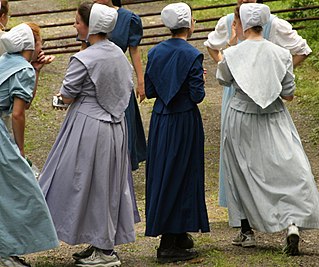Related Research Articles

The Mennonites are members of certain Christian groups belonging to the church communities of Anabaptist denominations named after Menno Simons (1496–1561) of Friesland. Through his writings, Simons articulated and formalized the teachings of earlier Swiss founders. The early teachings of the Mennonites were founded on the belief in both the mission and ministry of Jesus, which the original Anabaptist followers held to with great conviction despite persecution by the various Roman Catholic and Protestant states. An early set of Mennonite beliefs was codified in the Dordrecht Confession of Faith in 1632, but the various groups do not hold to a common confession or creed. Rather than fight, the majority of these followers survived by fleeing to neighboring states where ruling families were tolerant of their belief in believer's baptism. Over the years, Mennonites have become known as one of the historic peace churches because of their commitment to pacifism.

The Church of the Brethren is a Christian denomination with origins in the Schwarzenau Brethren that was organized in 1708 by Alexander Mack in Schwarzenau, Germany, as a melding of the Radical Pietist and Anabaptist movements. The denomination holds the New Testament as its only creed. Historically, the church has taken a strong stance for nonresistance or pacifism—it is one of the three historic peace churches, alongside the Mennonites and Quakers. Distinctive practices include believers baptism by trine immersion; a threefold love feast consisting of feet washing, a fellowship meal, and communion; anointing for healing; and the holy kiss.

The Evangelical United Brethren Church (EUB) was an American Protestant church formed in 1946, by the merger of the Evangelical Church and the Church of the United Brethren in Christ. The United Brethren and the Evangelical Association had considered merging off and on since the early 19th century because of their common emphasis on holiness and evangelism and their common German heritage.

The Brethren in Christ Church (BIC) is an Anabaptist Christian denomination with roots in the Mennonite church, pietism, and Wesleyan holiness. They have also been known as River Brethren and River Mennonites.
The Missionary Church is an evangelical Christian denomination of Anabaptist origins. They are committed to Jesus Christ, the Bible, and the Great Commission.

The Old Order River Brethren are a small Old Order Christian denomination with roots in the Mennonite church and German pietism through the Schwarzenau Brethren.
The Church of the United Brethren in Christ is an evangelical Christian denomination based in Huntington, Indiana. It is a Protestant denomination of episcopal structure, Arminian theology, with roots in the Mennonite and German Reformed communities of 18th-century Pennsylvania, as well as close ties to Methodism. It was organized in 1800 by Martin Boehm and Philip William Otterbein and is the first American denomination that was not transplanted from Europe. It emerged from United Brethren churches that were at first unorganized, and not all of which joined this church when it was formally organized in 1800, following a 1789 conference at the Otterbein Church.
The Bible Fellowship Church is a conservative pietistic Christian denomination with Mennonite roots.
The Fellowship of Evangelical Bible Churches (FEBC) is a small evangelical Christian denomination with an Anabaptist Mennonite heritage. Most of the denomination's approximately 5000 members are in congregations located in the U.S. and Canada.
The US Conference of Mennonite Brethren Churches (USMB) is an association of Mennonite Churches with origins among German speaking Mennonites in Russia which is more conservative than Mennonite Church USA.

The Canadian Conference of Mennonite Brethren Churches (CCMBC) is a community of about 250 diverse Mennonite Brethren (MB) congregations spread across Canada, united through their evangelical Anabaptist beliefs and values and by their mission to grow healthy churches, helping them reach their worlds.

The Mennonite Brethren Church was established among Plautdietsch-speaking Russian Mennonites in 1860, and has congregations in more than 20 countries, representing well over 300,000 believers as of 2003.

Mennonite Central Committee (MCC) is a relief, service, and peace agency representing fifteen Mennonite, Brethren in Christ and Amish bodies in North America. The U.S. headquarters are in Akron, Pennsylvania, the Canadian in Winnipeg, Manitoba.

Peace churches are Christian churches, groups or communities advocating Christian pacifism or Biblical nonresistance. The term historic peace churches refers specifically only to three church groups among pacifist churches—Church of the Brethren; Religious Society of Friends (Quakers); and Mennonites, including the Amish, Old Order Mennonite, and Conservative Mennonites—and has been used since the first conference of the peace churches in Kansas in 1935.

Martin Boehm was an American clergyman and pastor. He was the son of Jacob Boehm and Barbara Kendig who settled in Lancaster, Pennsylvania. Boehm married Eve Steiner in 1753 and in 1756 he was chosen by lot to become the minister of the local Mennonite church.
Samuel Hiestand was an American Bishop of the Church of the United Brethren in Christ, elected in 1833. He was the ninth Bishop of this Christian denomination.
Brethren is a name adopted by a wide range of mainly Christian religious groups throughout history which do share historical roots. The largest movements by this name are the Schwarzenau Brethren, Anabaptists, Moravian Brethren, and Plymouth Brethren.
References
- ↑ History of the Mennonite Brethren in Christ Church
- ↑ Bender, Harold S. (1957). "Mennonite Brethren in Christ". Global Anabaptist Mennonite Encyclopedia Online . Retrieved 7 July 2010.